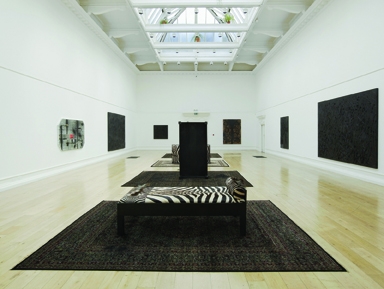For his first London solo show, American artist Rashid Johnson transforms the SLG’s main gallery into a strikingly original and dramatic space. The drama is carefully calculated, and the result is as deceptive as it is persuasive, gradually working its power over the audience like theatre.
Such an excessive transformation is not easily forgotten. Interestingly, the only comparable one that comes to mind is Chris Ofili’s The Upper Room, which he filled with monkey-god paintings at Victoria Miro in 2002. Like Ofili, Johnson’s work is inseparable from his heritage. Johnson, too, uses cultural references to blackness to seduce his audience, notably the sensual nature of the surface and texture of ethnic art, jazz music, and the symbolism of colour.
Where Ofili’s chapellike veil hung respectfully over the gallery space, Johnson’s creation is a mask, fully aware of its own cunning; where Ofili’s Room united its audience in awe before confounding them with the subject of the shrine (a monkey), Johnson’s Shelter works the opposite way.
On first entering, one is almost winded by the repetition of harsh black rectangles on the walls and floors, their shadowy edges echoing through a smashed mirror. Shelter’s elaborate soft furnishings – Persian rugs and chaises longues covered in the skins of farmed zebras, no less – are arranged in a row down the centre of the room, the sofas turned hostilely on their sides to reveal scratch marks in their black bases.
At first, the eye shies perversely from the brute hangings on the walls, which are made from flooring instead of canvas (black bathroom tiles or burned red oak boards) in a confusion of familiar domestic functions. The gaze is drawn instead to the middle of the room, where the animal skins, sucking the light in the way an exquisite oil painting might, remind us of the indignities of luxury. Next to the bitterly and inescapably politicised black art on white walls, nature’s immaculate patterns taunt us with their effortless harmony. As one acclimatises to the space, however, Johnson’s deceptively bland wall-hangings become skins themselves, each one subtly textured with symbolically rich materials like black soap, scarred with scratch marks or branded with hot metal.
The idea of a collective post-trauma clearly interests Johnson. Objects such as the Persian rugs and pot plants are references to Freud’s therapy room, the origin of Western psychotherapy’s model of an intimate healing space. They signal the idea that even though America has now voted its first black president in for another term, the scar left by the struggle of the last century is still itchy. The only colour in the room is a pile of red hardbacks: journalist Ellis Cose’s The End of Anger (2011). The question of how we make the complex and ambiguous racial problems of today as compelling as they were in their very unambiguous recent past is at the heart of Cose’s investigation. Johnson has given this same question a bitter but seductive flavour.
Ultimately, the themes of his show are familiar ones: beauty and skin. The only thing that really feels new is the grand, camp gestural confidence with which it is done. As in any good play, the drama lies in extreme exaggeration, and Johnson’s manipulative fortitude is surely a cause for celebration.
